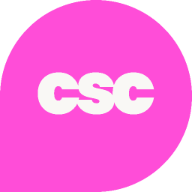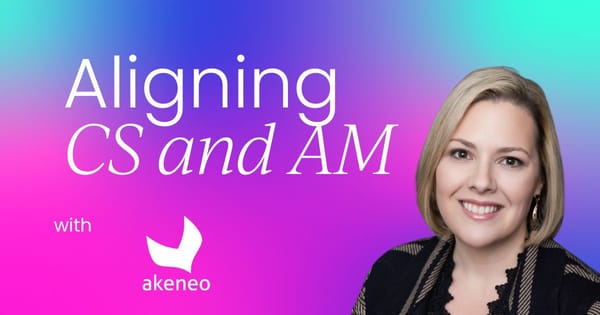If you're struggling to get customer success (CS) and account management (AM) on the same page, you're not alone. Misaligned goals, unclear responsibilities, and inconsistent handoffs can lead to frustrated teams and confused customers.
After all, they’re both doing similar jobs, right? They talk to the same customers, work toward the same outcomes, and yet – too often – they operate in silos.
This guide will show you how to fix that – from building a shared vision and defining roles, to managing change and driving measurable growth. Whether you’re starting from scratch or fine-tuning an existing process, you’ll walk away with practical steps on how to build that collaboration in a functional and sustainable way.
And, perhaps even more importantly, we’ll cover what you can do – starting tomorrow – to move things in the right direction.
Creating alignment between customer success and account management
Understand each other’s goals
Let’s talk about how to create your CS/AM dream team. It all starts with understanding what drives each team.
You’ve got to align on your goals. Be really clear about who does what, when, and why. I’ll be sharing some tips and resources to help with that. And, as with any change, expect more change to follow. So plan ahead, but also stay flexible – because pivots will definitely happen. That’s just how it goes.
One team, one dream
At Akeneo – and probably in a lot of other places, too – we like to say, “One team, one dream.” Easier said than done, right? But it’s true. If you want to be successful, your teams need to be aligned.
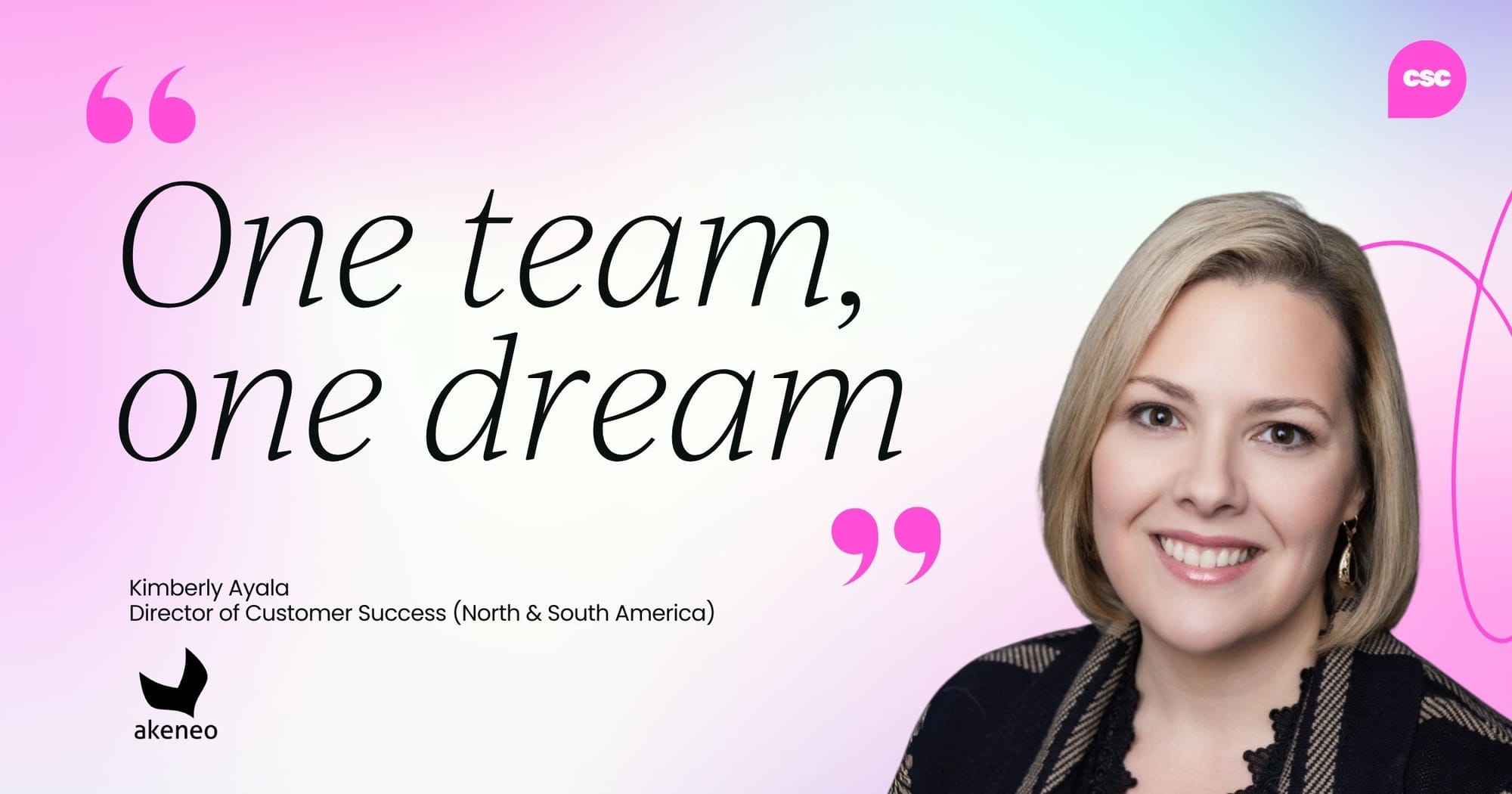
That starts with a shared vision. Create a unifying vision statement that both CS and AM can rally behind. And this has to start at the top. You need executive buy-in – your CEO, CRO, CCO – all the folks who influence how these teams operate. Don’t be shy about asking for that support.
Once the vision is clear, leaders at every level need to reinforce it. As a manager or director, you’ll want to communicate this vision constantly. It might feel repetitive, but that’s exactly what helps it stick. Connect your team’s daily work back to the larger mission again and again.
What’s in it for them?
Before crafting your vision statement, take a moment to step into your employees’ shoes. They’re going to be asking, “What’s in it for me?” Why should they care about aligning with another team? Why should they spend time on this?
So, frame your vision in a way that speaks to their goals, what motivates them, and what brought them to your company in the first place.
And don’t forget to consider the customer’s point of view, too. What are they ultimately trying to achieve? That should be at the core of your vision.
Keep it clear, concise, and specific
Your vision should be clear, to the point, and tied to your organizational goals. Don’t be afraid to get specific – numbers help! If you’re aiming to increase revenue by 10% or reduce customer costs by 15%, say so.
Here’s an example of a simple but effective vision statement:
“We work to provide customers with the tools and services to drive efficiency and lower costs so they can continue to grow.”
This could be for a SaaS company offering an AI product that streamlines workflows. If you have specific metrics, like driving efficiency by 20%, include them. It strengthens your message.
Turning vision into action
Once you’ve created your vision statement, the next step is putting it into practice.
Start by aligning on your metrics. Let’s face it – sales and CS often have very different goals. Sales wants to close deals, while CS is focused on retention and adoption. And sometimes, those objectives can seem at odds with each other.
But here’s the thing – at a deeper level, they’re not. When you zoom out, you’ll see that both teams are working toward the same big-picture goals. It’s just about getting aligned on how you measure success and where your efforts overlap.
Aligning incentives for seamless collaboration
Make KPIs part of the conversation
One of the best ways to align your CS and AM teams is to make sure their incentives and KPIs are connected. Everyone needs to be bought in – from leadership to the individual team members – and their goals should reflect this collaboration.
Let’s walk through a few examples that I’ve seen work well in different organizations.
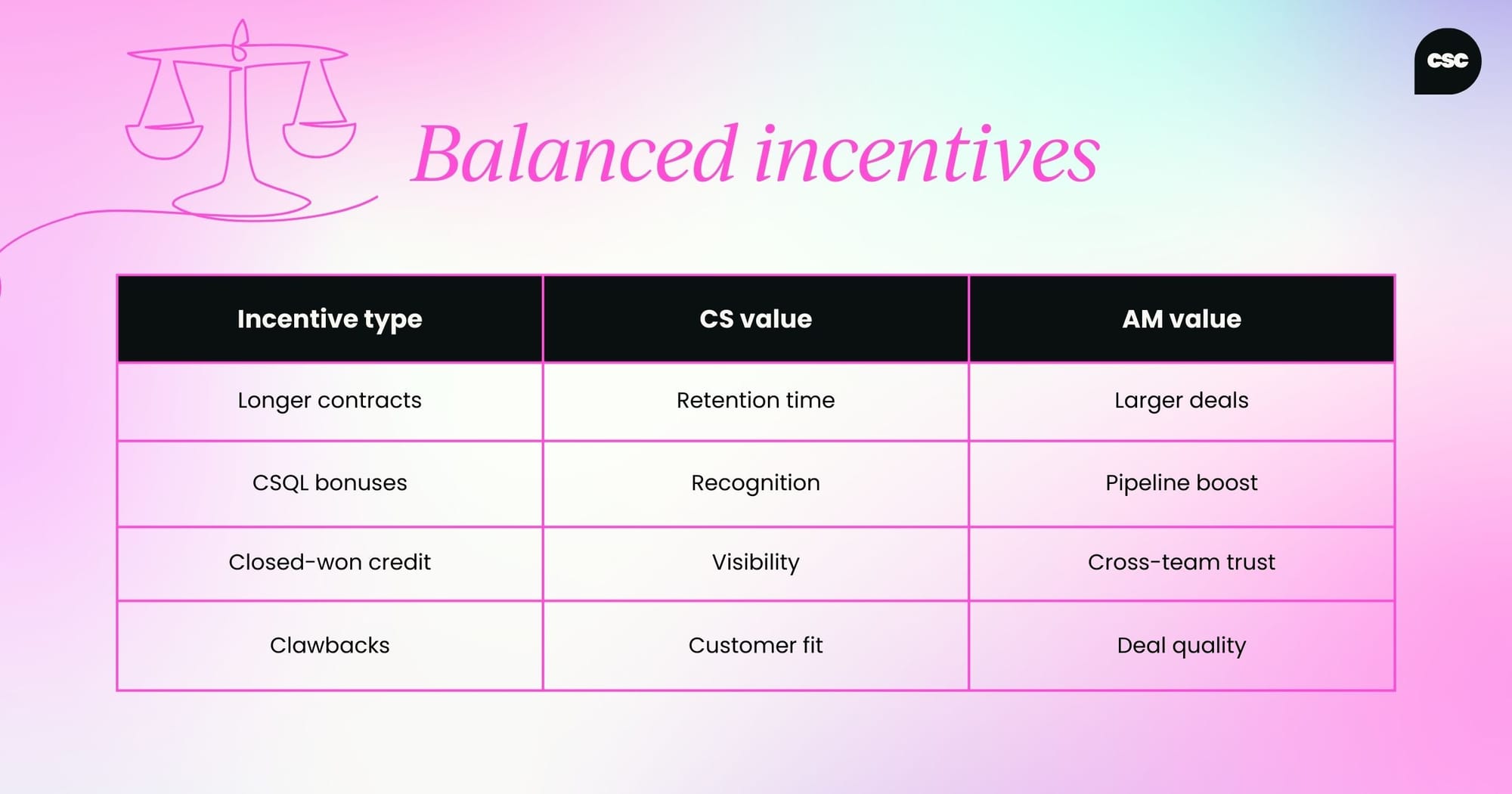
Compensation adjustments and clawbacks
First up, comp plan adjustments – specifically clawbacks for churn and contractions.
Let’s say an account manager closes a deal without properly rightsizing it. If the customer ends up churning or downgrading because they didn’t actually need what was sold, that should come back to the AM. Why? Because selling something that doesn’t meet the customer’s real needs puts the CSM in a tough spot and hurts the customer experience.
This type of structure encourages the sales team to think long-term, prioritize real value, and set the customer and the CSM up for success.
Incentivizing longer contracts
This one’s close to my heart. A lot of the time, it’s easier to win a short-term contract. It might even bring in more upfront revenue. But from a CS perspective, longer contracts are gold – they give you more time to build value and strengthen the relationship.
That’s why it’s important to incentivize sales teams to go after longer deals. You might offer a spiff (a little extra bonus) when a longer-term contract is signed. It helps align the teams, reduces churn risk, and gives everyone more room to deliver real impact.
Bonus: It also increases the chances of expansion, which benefits the AM as well.
Recognizing customer success qualified leads (CSQLs)
Here’s a term you might not have heard before: customer success qualified leads, or CSQLs.
Think of these like leads generated by your CS team. When a CSM spots an opportunity for expansion or cross-sell, they pass it along – and ideally, there’s a bonus tied to that lead, just like a BDR would get for a new customer lead.
This encourages CSMs to proactively surface opportunities and equips them with the right discovery questions. They’re closer to the customer and often hear the need first, so empowering them to act on that can have a huge impact on your pipeline.
It also gives proper recognition to the CSM for the revenue they help generate, while giving the AM a clear direction on where to go next.

Bonuses for closed-won opportunities
Last but not least, consider adding a bonus for CSMs when a deal they helped with closes.
Often, the CSM is the one with the strongest relationship, and they can help move things along when gaps pop up. Think of them as a bit of a double agent – someone who’s in the room, understands the customer deeply, and helps the AM deliver the right message at the right time.
This kind of alignment not only builds camaraderie between CS and AM, but also ensures the customer is truly getting what they need. And in the end, that means more value for the customer, more revenue for the business, and better retention all around.
Using a RACI chart to clarify responsibilities
What is a RACI?
Now that we’ve talked about alignment and incentives, the next step is defining who does what, when.
Enter the RACI chart. If you’re not familiar with it, RACI stands for:
- Responsible: Who’s doing the work
- Accountable: Who owns the outcome
- Consulted: Who gives input
- Informed: Who needs to be kept in the loop
It’s a great tool for avoiding confusion, especially as teams grow and more departments get involved.
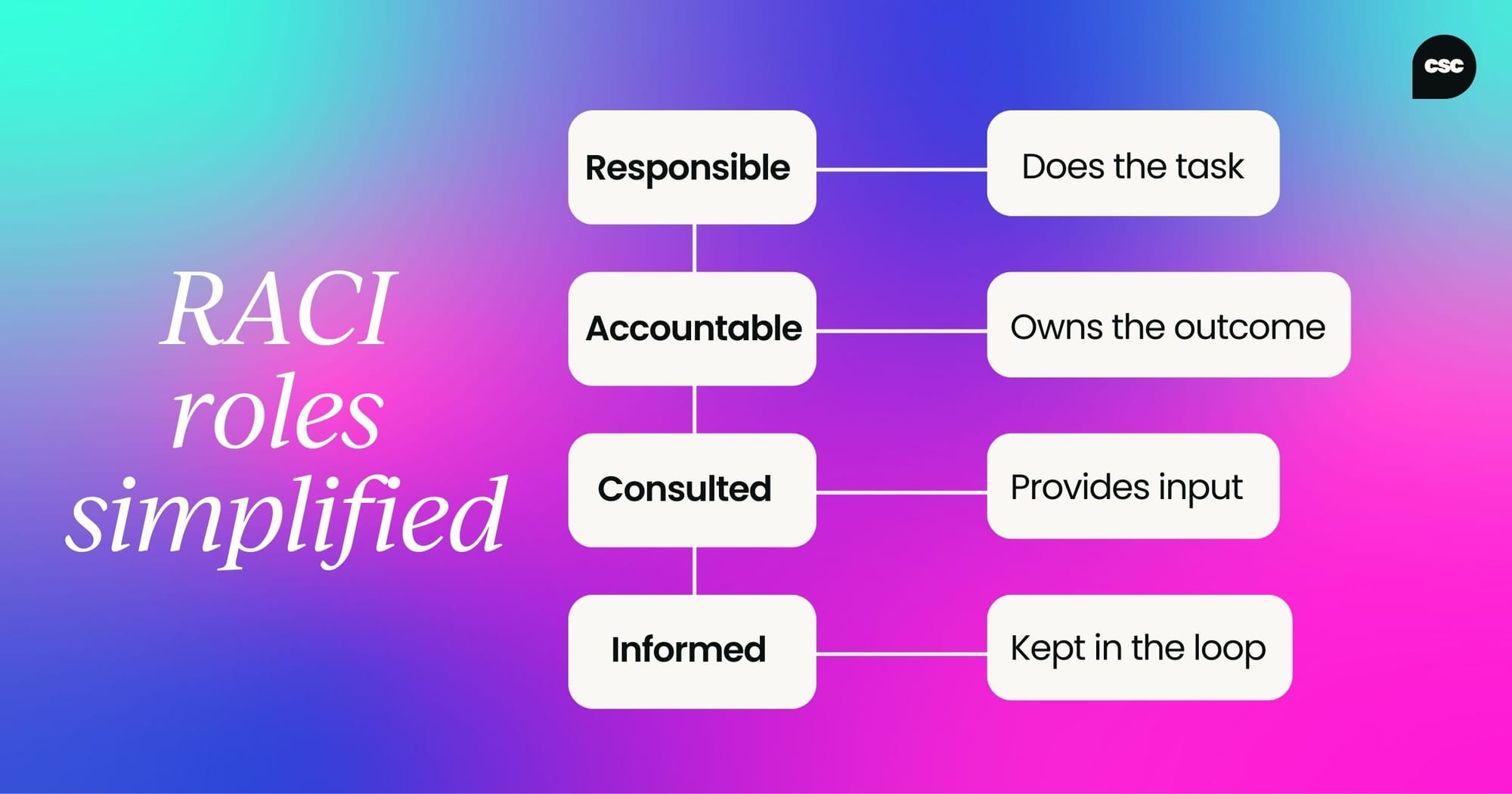
A simple example
Let’s walk through a basic example just to show you how it works.
Say a CSM identifies a customer need that could lead to expansion. They’re responsible for kicking off the process, creating the lead and setting up the internal sync call. The AM contributes by attending that call and following up afterwards.
Same thing with making a warm intro. The CSM takes the lead there, and the AM supports. It’s all about clear roles, smooth handoffs, and no dropped balls.
Scaling up with cross-functional collaboration
Now let’s look at a slightly more complex example, like prepping for a sales meeting.
In this case, the AM is accountable for creating the slides and doing the prep work. But they’re not working in a vacuum – the CSM, sales engineers, and even marketing are all contributing.
Marketing might supply slide templates or messaging that supports the value proposition. Sales engineers can provide technical insights. Everyone plays a part.
So don’t limit your RACI to just CS and AM – think cross-functionally. The more departments involved, the better aligned your efforts will be.
Driving in different vehicles, same destination
Here’s a fun little analogy I like to use: Think of each department as driving a different vehicle, but you’re all headed to the same destination. Some folks might take the scenic route, others go straight down the highway – but as long as you’re aligned on where you’re going, it all works.
And if everyone understands the vision and their role in achieving it, you’ll get there a lot faster, with fewer detours and less confusion along the way.
Get specific to avoid confusion
Here’s my final tip on this: get really, really specific.
Look closely at your customer journey and your sales process. Break it down into every tiny task – follow-ups, admin work, negotiation steps, paperwork – all of it.
The more detailed your RACI, the fewer things fall through the cracks. When it’s unclear who’s responsible for what, things get missed. And that’s when deals go cold or relationships weaken.
Don’t wait for problems to pop up. Define the roles up front, get everyone aligned, and keep those wheels turning.
Oh, and if you’re looking for a more detailed RACI template, Customer Success Collective has a great one. Definitely worth checking out!

Navigating conflict, change, and community
Address conflict early
Let’s talk about conflict resolution – something I mentioned earlier, and now we’re diving in.
My biggest advice? Don’t let small issues grow. Encourage your teams to bring up feedback early and often. At first, they may be a little overly compliant, especially if they’ve had rough experiences in the past. That’s okay – just take it in stride and keep looking forward. That mindset helps resolve most conflicts before they escalate.
And always, always go back to your shared vision. Repeat it often (yes, almost to the point of overkill). Reinforce that you’re working together to help your customers succeed and to move the company forward in tangible ways. That message grounds everyone when tensions rise.
Measuring success with internal and external KPIs
You’ll want to track both internal and external KPIs to gauge how effective your efforts are.
Internal KPIs
These tell you how your team is doing. Are CS and AMs aligned? Are they communicating effectively? Do they feel supported and clear on their responsibilities?
Look at employee sentiment, satisfaction, and team dynamics. Watch for gaps, confusion, or resistance. And always check that the documented process is actually being followed.
Leadership should regularly check in and make sure tasks aren’t slipping through the cracks, especially those nitty-gritty admin details. I’ve seen what happens when no one owns documentation: complete chaos on forecast calls.
External KPIs
Now, let’s talk results. This is where it all comes down to what I call the “money metrics”:
- Is your pipeline growing?
- Are you generating more CSQLs?
- Are those opportunities closing as won?
- Are renewals strong, and risk levels decreasing?
- Are you seeing more expansion, which in turn boosts retention?
And of course, check your CSAT scores and voice of the customer feedback. Make sure customers aren’t feeling your org chart – they should experience a seamless journey, knowing exactly who to reach out to at every stage. That comes down to clear external communication and setting expectations.
Pivot when needed – with purpose
Things won’t always go according to plan. When that happens, be ready to pivot – and yes, I can’t help but think of Ross from Friends yelling “Pivot!” while dragging that couch up the stairs. (Sorry if that’s stuck in your head now.)
But seriously, if something’s not working, go back to your RACI. Reassess who’s doing what and when. Maybe you need to loop in more resources or clarify expectations. And when you do make a change, don’t forget to re-enable the team – update documentation, communicate clearly, and reinforce, reinforce, reinforce.
People will say, “Wait, I thought we did it the other way?” That’s normal. Be patient, be clear, and stay aligned.
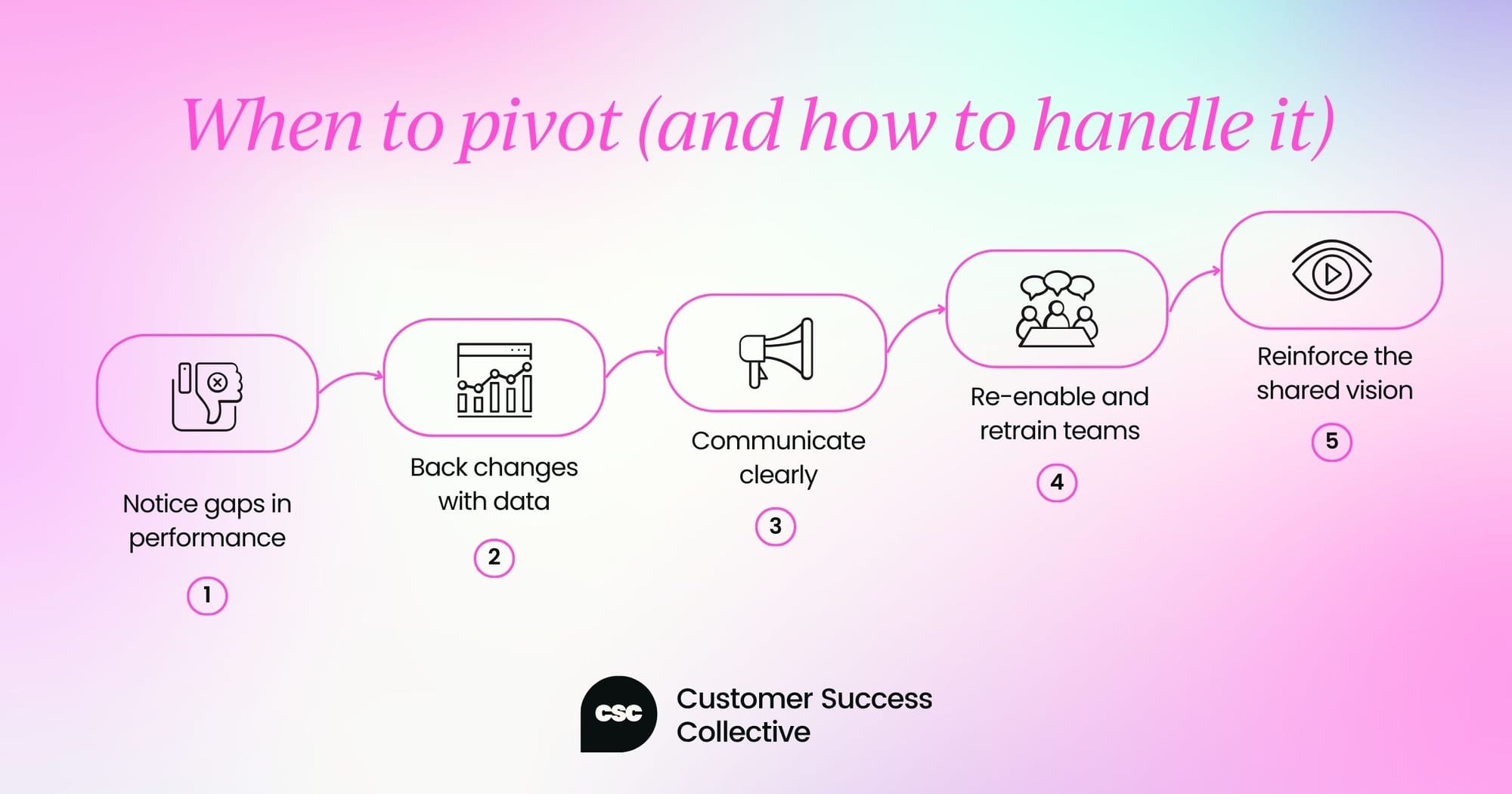
Avoiding change fatigue
If you’ve been through a reorg (or several), you know change fatigue is real. One day, you finally feel like you’ve got it down – and the next, everything shifts again. It’s exhausting.
So, anytime you pivot, make sure you explain why. Use data. Show the gaps – pipeline isn’t growing, sales aren’t closing, and ownership is unclear. Whatever the reason, back it up with evidence.
Especially if people feel like they’ve had success with the current process, they’ll naturally question why you’re changing it. Be ready for those conversations, and support your decisions with data that ties directly to revenue. That’s your strongest case.
Also, keep celebrating your quick wins. Recognize what has gone well, even while acknowledging that adjustments are needed.
Back to the vision – always
At every step, circle back to your vision. Remind your teams what you’re all working toward, and make it central to your communication strategy.
So, what are your next steps?
- Create your vision statement, and involve cross-functional colleagues and leadership to shape it.
- Build your RACI document and share it widely.
- Enable your teams so they understand the process from start to finish.
- Manage change actively – and be ready to pivot as needed.
Helpful resources to guide your journey
If you’re still unsure where to start, Customer Success Collective has a fantastic library of resources – videos, blogs, articles, templates, and even podcasts. (You might even hear from me there!)
Some of my favorite templates include:
They're super helpful first steps, even if you’ll need to tailor them a bit for your team.
My favorite go-to on change management
I’m also a big fan of John Kotter – I talk about him all the time. If you’ve seen me at a conference, you’ve probably heard me mention his work.
My go-to recommendation is his book Leading Change – it’s a great primer on how to lead change in both small and large organizations. If you want to go deeper, check out A Sense of Urgency, which is another excellent follow-up.
Tap into the customer success community
One of the best things about working in customer success is the community. We are so lucky to have a network of CSMs, leaders, and CS advocates who are genuinely open to helping each other.
Attend conferences. Join conversations. Get active on LinkedIn. Look for the names that keep popping up and follow their content. Most people are more than happy to chat or share resources if you reach out. Take advantage of that.

This article is based on a workshop Kimberly gave called "The power duo: CSMs and Account Managers" at Customer Labs on March 19, 2025.
Upcoming workshops
Ready to level up your customer success skills? Our workshops run twice a quarter on Wednesdays, bringing you expert-led, hands-on learning experiences designed to solve real CS challenges.
- Go-to-market for success with Minna Vaisanen (May 21)
- Enhancing CS through personalized engagement with Raymond Otero (May 21)
- Transform customer success into a revenue powerhouse with Harini Gokul (June 18)
- Strategic CS leadership with Andreja Mrzel (September 17)
- Elevate your CSM career with Elizabeth Blass (October 22)
- Build high-performing customer success teams with Dominique Duquennoy (November 19)
Each workshop offers exclusive frameworks, actionable strategies, and collaborative learning opportunities to help you drive retention, enhance satisfaction, and align customer success with your business goals.
Don't get FOMO
Register now to join industry leaders from companies like Microsoft, Entrust, and Blackline in these transformative sessions. Take what you learn back to your team and create bespoke programs that drive measurable success together.



 Follow us on LinkedIn
Follow us on LinkedIn